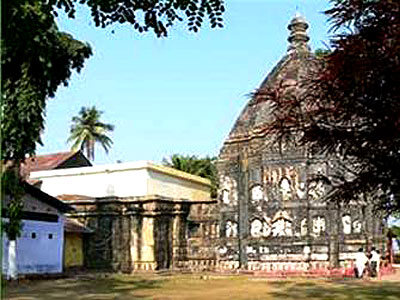 Hayagriva Madhab Temple has been the most celebrated temple which is dedicated to Lord Vishnu in the form of Lord Krishna. The temple has been named after one of the incarnations of Lord Vishnu. Hayagriva is the incarnations of Lord Vishnu which means Vishnu with horse head. Here Lord Vishnu is specially worshipped even to day. Hayagriva Madhava temple located at Hajo is built on a hill called "Manikuta". Known for a number of legends this is one of the most popular sights in Assam.
Hayagriva Madhab Temple has been the most celebrated temple which is dedicated to Lord Vishnu in the form of Lord Krishna. The temple has been named after one of the incarnations of Lord Vishnu. Hayagriva is the incarnations of Lord Vishnu which means Vishnu with horse head. Here Lord Vishnu is specially worshipped even to day. Hayagriva Madhava temple located at Hajo is built on a hill called "Manikuta". Known for a number of legends this is one of the most popular sights in Assam.
Legend of Hayagriva Madhab Temple
There are a number of legends regarding the incarnation of the Hayagriva Madhab. It has three versions while the local legend relates the Avatara to the epic of Mahabharata. It claims that when Vishnu was sleeping and Lord Brahma was on the lotus, two demons Madhu and Kaitabha took away the Vedas from Brahma and went to Rasatala. Lord Brahma, being much aggrieved, awoke Vishnu, and requested for the recovery of the Vedas. Vishnu assumed the form of Hayagriva and recovered the Vedas, and handed over to Brahma. He then went to sleep in the northeast in the form of Hayagriva when he was challenged by the demons for a war in which they were killed.
According to Matsya Purana, the Hayagriva Avtara of Vishnu was similar to the Matsya avatar which he took when the worlds were burnt down. Vishnu in the form of a horse recompiled the four Vedas, Vedangas, etc., the Devi Bhagavata and the Skanda Purana in its Dharmranya Khanda.
According to Kalika Purana Vishnu took the form of Hayagriva to kill the Fever-Demon, Jvarasura in the Manikuta hill and lived there for the benefit of men, gods and Asuras. He then took a sacred bath to avoid all vices which come in the form of diseases.
Along with this there is the city of Apunarbhava where Janardana Hayagriva resided. This place is full of gardens, temples and parks which are known for its beauty. It was believed that a demon named Hayagriva also resided in the city who was killed by the Jagatpita or Lord Vishnu. Along with this the place is also considered scared by the Buddhists. Manikuta is considered as holy by the Buddhists of Tibet and Buddhists of the neighbouring Bhutan hills who come down during the cold season to worship the god whom they regard as Mahamuni Buddha. While the original temple of Hayagriva-Madhava was destroyed, it was rebuilt by King Raghudeva Narayana, son of Sukladhwaj, in Saka 1505 (1583 AD).
Architecture of Hayagriva Madhab Temple
Hayagriva Madhab Temple is also known for its general layout and its architecture. Built on a small hillock, the temple has a flight of stone steps composed of slab(s) leads to the main grounds of the temple.
The temple is built in stone in an octagonal shape which is about 30-feet in diameter and crowned with a pyramidal roof. It often appears that the upper portion of the temple has been reconstructed from the old (earlier) materials, without much resemblance with rest of the architecture.
In its vertical elevation, the temple consists of three parts, the high basement, the middle portion of the temple and the Sikhara. It has the sculptures of row of Elephants or `Gajathara`. At a height of 2-feet above the plinth, a row of caparisoned elephants are encircled. The images of elephants, all tuskers, are facing outwards, each standing 16" in height, which are finely designed and executed showing only their tusks, trunks and front legs. The basement moulding is identical with the decorative style that resembles with `Kailasa` cave temple at Ellora.
The Garbha griha is 14 feet square shaped crypt, into which one can descend by a flight of stone steps. It contains the image and its platform. The shrine is formed of four blocks of granite which is ten feet high by five feet wide. While a lotus over the door, it opens into an anteroom. Also there is a stone screen, ten feet by ten feet, having niches of four feet square, one on each side with apertures for the admission of light and air. This is shaped in the form of lotus flowers. The temple has a Sikhara which has a pyramidal plane face, which continues right upto an apex point. The temple, it has large vestibule measuring 40 feet by 20 feet built of brick in the horizontal aspect which resting on massive brick pillars. This is a new addition to the original structure, constructed by Naranarayan, the Koc King in 1550 AD.
Sculpture of Hayagriva Madhab Temple
The exterior of the temple contain life-size sculptured figures representing the ten Avataras with Lord Buddha as the ninth which are placed in the upper walls of the temple. The rest of the figures are more or less non-descriptive and they are mostly male figures which carry a trident (`Trishul`). According to the Buddhist Lamas, these figures were originally inside the temple, but were ejected by Buddha.
The temple was large maintained by the revenue from the land endowed to it by the kings. Artisans and others were paid from the temple funds. The chief priest of the temple is called "Dalai" elected from among the local priests and holds his office till his death. He resides in a large house situated at the foot of the hill. This is among the unique temples Kamrup district which is seen by camping at Gawahati.











